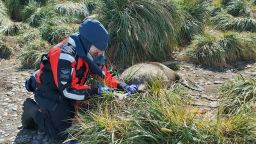Editor’s Note: Jaime M. Yassif, Ph.D., is the vice president of Global Biological Policy and Programs at the Nuclear Threat Initiative, a non-profit global security organization focused on reducing nuclear and biological threats imperiling humanity. The views expressed in this commentary are her own. Read more opinion at CNN.
The headlines are concerning: “Highly pathogenic avian influenza found in Texas, Kansas dairy cattle.” “Bird flu detected in dairy worker.” “First human case of avian flu in Texas raises alarm.” Could this be how the next pandemic begins? Well, so far US officials are saying they believe there is minimal risk to the public from the latest iteration of bird flu.

But with growing evidence of potential mammal-to-mammal spread just weeks after the new bird flu was detected in cows, many of us in the biosecurity and pandemic preparedness community believe that leaders in capitals around the globe should be working to get ahead of this new public health threat in case the H5N1 flu virus gains the ability to spread among humans.
There have also been documented cases of transmission to people: Earlier this month, the US Centers for Disease Control and Prevention announced that a second person in the US had tested positive for bird flu. The first US H5N1 human case was in 2022, involving a poultry worker in Colorado, and the more recent case involved a dairy worker who had direct contact with infected cattle in Texas. Both human cases had mild symptoms, were treated and fully recovered, but previous bird flu cases in other parts of the world have been much more severe, causing fatalities in many cases. What we don’t know — and what has scientists worried — is whether the virus will evolve in a way that enables it to spread more readily among human populations.
In March, a first case was reported of H5N1 virus in cattle and while direct cow-to-cow transmission has yet to be confirmed, the occurrence of cases in cattle across at least six states suggests that cows may be transmitting the flu virus directly among themselves as they are transported to different farms, as opposed to being infected by sick birds.
While we face uncertainty about what will happen next, many scientists say stepped-up government action is warranted because of the risk that bird flu could turn into a pandemic. Many researchers believe that Covid-19 may have started in a similar way — spreading from animals to humans by first gaining the ability to spread among mammals that came into contact with humans, and then evolving to transmit directly between humans.
The US and other governments around the world need to take H5N1 seriously and demonstrate that we’ve learned the lessons of the Covid-19 pandemic that turned our lives upside-down for years. They should take immediate steps to get out ahead of this risk rather than taking a “wait and see” approach.
In the short term, governments should act now to deploy the capacities at their disposal to guard against the uncontrolled spread of the H5N1 bird flu virus if it evolves to spread between people. This includes funding research on vaccines that are likely to be effective against the virus, stepping up surveillance of livestock and humans and wider emergency response planning.
It has been encouraging to hear that the US Department of Health and Human Services has stepped up surveillance systems and supported testing of potential vaccine candidates that could be more effective against this strain of bird flu than the existing, limited stocks of H5N1 vaccine developed many years ago.
Moving forward, it will be critical for human and animal health sectors — including the CDC and the US Department of Agriculture — to work together on bio-surveillance, including by developing a shared approach to monitoring human and animal populations and by exchanging data, to keep tabs on how the virus is evolving.
Additionally, if the US government succeeds in identifying an effective vaccine for the new bird flu, it will be important to draw up plans to rapidly produce the vaccine, so that it is ready to go if needed. Further, the US and other governments should think through how to update and act on their existing pandemic flu response plans in case H5N1 begins to spread among humans.
To be prepared for a possible outbreak of bird flu, governments around the world need to take these steps now, even in the face of uncertainty. If they wait for a confirmed outbreak among people, it will be extremely difficult to prevent the uncontrolled spread of the virus.
It’s also time to reassess the long game and make sure that countries around the world have the capacity to detect and respond to future epidemics and pandemics. According to the Global Health Security Index, there are significant gaps in countries’ pandemic preparedness capabilities.
During the Covid pandemic, we witnessed firsthand that capacity matters when it comes to saving lives. According to a study released last year by experts from the Brown University Pandemic Center, the Gates Foundation and NTI, almost all countries that had strong pandemic preparedness capacity at the outset of Covid had lower death rates than less prepared nations.
A broad range of capacities have been shown to be effective, including disease detection systems, systems for distributing medical countermeasures and public health infrastructure to deploy non-pharmaceutical interventions.
Playing the long game means investing now to make sure that countries have the capacity they need to respond to a worst-case H5N1 pandemic or to be prepared for the next one. Given the impact of Covid, it is deeply disappointing that national governments are not investing the necessary resources to build life-saving pandemic preparedness capacity. This just doesn’t make sense.
In the United States, federal funding for pandemic influenza is far below what we need to effectively tackle this threat. Government experts have called for $1.15 billion in funding for pandemic influenza for 2025, but the Biden administration has requested only $335 million. Making matters worse, Congress has made major cuts to pandemic preparedness funding, as part of the ongoing appropriations process.
This is also an issue internationally. Most countries — even those with ample resources — have not made financial investments in strengthening pandemic preparedness. The 2021 Global Health Security Index — which measures national-level pandemic preparedness capacity and which was collaboratively developed by NTI, the Johns Hopkins Center for Health Security and Economist Impact — found that 155 out of 195 countries have not allocated funds within the last three years to improve capacity (aside from public health emergencies) to address epidemic threats.
The White House just announced a new Global Health Security Strategy, which includes a commitment to work with 50 countries to build pandemic preparedness capacity. This is a great step in the right direction, but the US government and their partners will need to make sure they have the financial resources and political will to follow through on this pledge.
Get Our Free Weekly Newsletter
- Sign up for CNN Opinion’s newsletter
- Join us on Twitter and Facebook
Playing the long game also means supporting the World Bank Pandemic Fund, which is designed to invest in long-term pandemic preparedness capacity of low- and middle-income countries. The fund received $1.9 billion dollars in pledged resources from national governments, philanthropic organizations and other groups, but it is making grants to support valuable capacity building efforts and will soon run out of funds. Experts estimate that it will take approximately $10 billion per year for at least five years to provide the funding that will allow countries to build infectious disease detection and response capacity that will be needed to guard against pandemics. We must do better.
Covid made pandemic risks clear, and unfortunately in many parts of the world, we witnessed the deadly consequences. Governments need to act quickly and decisively now, to get ahead of the growing H5N1 flu public health threat, while also investing in long-term capacity building to make sure the world is better prepared for the next pandemic.







